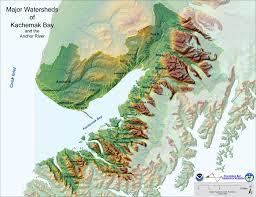Ocean acidification and climate change have become more prominent topics of conversation over the past few years, especially in areas heavily dependent on the sea, like Alaska.
“The ocean conditions are changing and that’s something that we want to understand as well as we can so that we can be better prepared to address those changes and help our coastal communities be more resilient to those changes,” Julie Speegle, who works with the Alaska region of the National Marine Fisheries Service, said.
She says Kachemak Bay joins seven other habitat focus areas nationwide under NOAA’s Habitat Blueprint initiative. And it was a logical choice.
 “One of the special things about Kachemak Bay is we have already gathered quite a bit of data on ocean conditions and habitat there,” says Speegle. “What we haven’t done is put all that data together and see what comes out of it, what we can learn from it.”
“One of the special things about Kachemak Bay is we have already gathered quite a bit of data on ocean conditions and habitat there,” says Speegle. “What we haven’t done is put all that data together and see what comes out of it, what we can learn from it.”
The bay is already a State of Alaska Critical Habitat Area and a National Estuarine Research Reserve. So, the building blocks are already in place. She says the blueprint initiative provides the framework for organizations to efficiently work together in a targeted area.
“So, we basically select habitat focus areas where we can prioritize resources and activities and foster and leverage partnerships to address changes in coastal and ocean habitats,” says Speegle.
NOAA already has relationships with outside groups in the Kachemak Bay area, including tribal governments, regional citizens advisory councils, municipal bodies, and environmental interest groups like the Center for Alaskan Coastal Studies.
But the designation also encourages NOAA to make a concerted effort within the branches of its own organization.
“So, you’ve got NOAA’s National Ocean Service, National Weather Service, National Marine Fisheries Service and we’ll be working together internally to focus our efforts on Kachemak Bay,” says Speegle.
But what does that mean practically?
Speegle says it provides groups with the incentive to conduct scientific studies and the facilities to streamline data sharing. But it also has the potential to ease the financial burden that’s often a barrier to ongoing research programs. She says there is some federal funding that opens up to projects once they are designated within a habitat focus area.
The research and information that comes out of these projects will reach beyond Kachemak Bay as well.
“So, as we go forward, we’ll be sort of using Kachemak Bay as a testing area to improve NOAA mapping and model information,” says Speegle. “And we have a goal of developing new tools for habitat assessment that can be used not just in the Kachemak Bay area, but other coastal areas throughout Alaska.”
Speegle says the next step is to evaluate ongoing studies and what’s already in place. Overall, she hopes Kachemak Bay will provide some more insight into changing ocean conditions and the best ways to manage those changes for the future.




